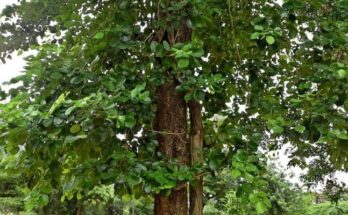|
Getting your Trinity Audio player ready...
|
Spring is a season of new beginnings, renewal, and hope, and one of the most beloved symbols of this season is the cherry tree. With its delicate, pink or white blossoms, the cherry tree is a popular ornamental tree in gardens, parks, and streets around the world. But the cherry tree is more than just a pretty face; it has a rich cultural history and is an important part of the ecosystem.
Scientific Classification of a Cherry Tree (Prunus Avium)
| Kingdom | Plantae |
|---|---|
| Phylum | Angiosperms |
| Class | Eudicots |
| Order | Rosales |
| Family | Rosaceae |
| Genus | Prunus |
| Species | Prunus avium |
Cultural Significance of Cherry Tree
The cherry tree has a long history in many cultures, and its symbolism varies depending on the context. In Japan, cherry blossom viewing, or hanami, is a national tradition that dates back more than a thousand years. During this time, people gather under cherry trees to enjoy picnics and parties with family and friends, often at night when the trees are illuminated. The cherry blossom is also a symbol of the transience of life, reminding us to appreciate the beauty and fragility of our existence.
In the United States, the cherry tree is most famously associated with the story of George Washington and the cherry tree. According to the legend, a young George Washington chopped down a cherry tree and then confessed to his father, saying, “I cannot tell a lie.” While the story is likely apocryphal, it has become a beloved part of American folklore, and cherry trees are now planted in many parts of the country as a symbol of patriotism and national pride.
Cherry Tree: Fun Facts You Might Not Know
- Cherry trees are members of the Rosaceae family, which also includes roses, peaches, and apples.
- Cherry trees are native to the temperate regions of the northern hemisphere, including Europe, Asia, and North America.
- The cherry tree is a deciduous tree, meaning it sheds its leaves in the fall and grows new leaves in the spring.
- Cherry trees can live for up to 20-30 years, depending on the variety and growing conditions.
- The fruit of the cherry tree is technically a drupe, which means it has a hard pit or stone in the center surrounded by juicy flesh.
- Cherry blossoms are not just pink or white; there are over 200 different varieties of cherry blossoms, ranging in color from pale pink to dark red.
- In Japan, the arrival of the cherry blossom season is closely monitored and reported by the media, and there are even cherry blossom forecasts to help people plan their hanami, or cherry blossom viewing, parties.
- Cherry trees played an important role in World War II, as American and Japanese soldiers both admired the beauty of the cherry blossoms in Japan and took inspiration from their transience and fragile beauty.
- Cherries have been cultivated for thousands of years, with evidence of cherry cultivation dating back to ancient civilizations in Greece, Rome, and China.
- Cherry trees are an important food source for many animals, including birds, squirrels, and bears. In fact, bears are known to climb cherry trees to get at the fruit!
Don’t Miss: Chinese Money Plant, Care, Benefits, Flowers & Propagation
Cherry Tree Benefits: Why This Fruit-Bearing Tree Is So Valuable?
Cherry trees are more than just pretty pink blossoms in the springtime. They are also valuable fruit-bearing trees with a host of health and environmental benefits. Here are some of the top benefits of cherry trees that make them a valuable addition to any garden or community.
- Nutritious Fruit: Cherry fruit is packed with vitamins and minerals, including vitamin C, potassium, and fiber. Tart cherries, in particular, are high in antioxidants and have been shown to have anti-inflammatory and pain-relieving properties.
- Low in Calories: One cup of cherries contains only 90 calories, making them a great low-calorie snack or ingredient in desserts.
- Easy to Grow: Cherry trees are relatively easy to grow, even for beginner gardeners. They prefer full sun and well-drained soil, and there are many varieties to choose from that can thrive in different climates and growing conditions.
- Beautiful Blossoms: The pink or white blossoms of the cherry tree are a beloved symbol of springtime and are often used in floral arrangements and decorations.
- Carbon Sequestration: Like all trees, cherry trees absorb carbon dioxide from the atmosphere and store it in their wood and leaves, helping to mitigate the effects of climate change.
- Habitat for Wildlife: Cherry trees provide food and habitat for many species of birds, insects, and mammals, including bees, butterflies, and squirrels.
- Economic Value: Cherries are a valuable agricultural crop, with the global cherry market estimated to be worth over $7 billion USD. Growing cherry trees can provide a source of income for farmers and contribute to local economies.
Ecological Importance
Cherry trees are not only beautiful but also play an important role in the ecosystem. They are pollinated by bees and other insects, which help to maintain biodiversity and ensure the health of other plants and animals. The fruit of the cherry tree is also an important food source for birds and mammals, including squirrels, raccoons, and bears.
Cherry trees are also part of a larger group of trees known as fruit trees, which provide a range of benefits beyond their aesthetic value. Fruit trees help to reduce soil erosion, improve air quality, and provide shade and habitat for other plants and animals. They also produce nutritious and delicious fruit, which is an important part of a healthy diet.
Cherry trees not only provide a stunning display of blooms in the spring, but they also bear delicious and nutritious fruit. Cherry fruit comes in a variety of colors and flavors, ranging from sweet to tart, and is a favorite of many people around the world.
Don’t Miss: Parijat Tree | Benefits, Flower, Characteristics, & Significance
20 Varieties of Cherry Fruit
- Ranier Cherry: Known for its golden-yellow skin and sweet, juicy flesh, the Ranier cherry is a prized variety with a unique flavor reminiscent of honey.
- Black Tartarian Cherry: This dark, nearly black cherry is sweet and rich in flavor, making it a popular choice for fresh eating and desserts.
- Bing Cherry: The Bing cherry is a deep red, sweet, and plump variety, often considered the “classic” sweet cherry and a favorite for snacking.
- Sour Montmorency Cherry: Tart and bright red, Montmorency cherries are commonly used in pies, preserves, and sour cherry juice.
- Stella Cherry: Stella cherries are self-pollinating and produce large, dark red, and sweet fruits, making them a great choice for home orchards.
- Lambert Cherry: Lambert cherries are known for their rich, sweet, and slightly tart flavor, making them ideal for both fresh eating and culinary uses.
- Skeena Cherry: These dark red, firm cherries have a balanced sweet-tart flavor and are popular for fresh consumption and baking.
- Black Pearl Cherry: A newer variety, Black Pearl cherries are nearly black in color and offer a deep, rich flavor with a hint of sweetness.
- Hedelfingen Cherry: This German variety features dark, juicy cherries with a sweet-tart flavor, perfect for fresh eating and preserving.
- Utah Giant Cherry: As the name suggests, these cherries are exceptionally large, sweet, and juicy, making them great for snacking and desserts.
- Lapins Cherry: Lapins cherries are self-pollinating and produce sweet, dark red fruit with a rich, complex flavor.
- Rainier II Cherry: An improvement of the classic Rainier, Rainier II cherries are exceptionally sweet with a distinctive yellow skin and red blush.
- Van Cherry: Van cherries are a versatile variety, well-suited for fresh eating, baking, and canning, with a balanced sweet-tart flavor.
- Santina Cherry: Known for its sweet and tangy flavor, Santina cherries have a vibrant red color and are excellent for both fresh consumption and cooking.
- Kordia Cherry: These large, dark cherries have a rich, sweet taste and are ideal for snacking and culinary applications.
- Napoleon Cherry: Also known as Royal Ann or Queen Anne, these cherries are primarily used for canning and making maraschino cherries due to their firm, pale yellow flesh.
- Samba Cherry: Samba cherries are sweet, dark, and juicy, making them an excellent choice for fresh eating and desserts.
- Balaton Cherry: Balaton cherries are a type of tart cherry with dark red flesh, perfect for pies, jams, and other culinary uses.
- Starkrimson Cherry: These cherries are deep red with a sweet, slightly tart flavor, making them a delightful addition to fruit salads and snacks.
- Carmine Jewel Cherry: A sour cherry variety, Carmine Jewel cherries are known for their intense tartness, making them ideal for baking and preserves.
20 Health Benefits of Cherry Fruit
- Eyesight Improvement: Cherries are rich in vitamin A, which is essential for good vision and may help reduce the risk of age-related macular degeneration.
- Reduced Migraine Intensity: Some studies suggest that the anti-inflammatory and pain-relieving properties of cherries may help reduce the intensity and frequency of migraines.
- Joint Lubrication: The natural compounds found in cherries can contribute to joint health by aiding in the lubrication of joints and potentially reducing the risk of arthritis.
- Oral Health Support: Cherries contain natural compounds that may help prevent tooth decay and gum disease by inhibiting the growth of harmful oral bacteria.
- Stress Reduction: Consuming cherries can aid in stress reduction due to their high vitamin C content, which helps regulate stress hormone levels.
- Skin Rejuvenation: The antioxidants in cherries may promote skin rejuvenation by combating free radicals and supporting collagen production.
- Respiratory Health: Cherries are a source of quercetin, which can have a positive impact on respiratory health by reducing the severity of allergy symptoms and asthma attacks.
- Gut Health: The fiber in cherries supports gut health by promoting the growth of beneficial gut bacteria, which can improve digestion and reduce the risk of digestive disorders.
- Enhanced Memory: Some research suggests that the antioxidants in cherries may have a positive effect on memory and cognitive function, potentially reducing the risk of age-related cognitive decline.
- Anti-Radiation Properties: Cherries contain compounds that may help protect the body from the harmful effects of radiation exposure.
- Improved Fertility: Cherries are a source of vitamins and minerals that may enhance fertility by promoting healthy reproductive systems in both men and women.
- Metabolism Boost: Compounds in cherries can help boost metabolism, making it easier to manage body weight and maintain a healthy body composition.
- Alleviation of PMS Symptoms: Some women find relief from premenstrual syndrome (PMS) symptoms such as bloating and cramps by incorporating cherries into their diet.
- Liver Detoxification: Cherries can support liver health by aiding in the detoxification process, helping the body eliminate harmful substances.
- Wound Healing: The vitamin C in cherries is important for collagen production, which is essential for wound healing and tissue repair.
- Blood Sugar Regulation: Cherries have a low glycemic index and can be part of a balanced diet to help regulate blood sugar levels.
- Enhanced Lung Function: Consuming cherries may contribute to improved lung function and reduce the risk of respiratory conditions.
- Cholesterol Management: The fiber and antioxidants in cherries may help manage cholesterol levels, reducing the risk of heart disease.
- Immune System Support: The vitamin C in cherries boosts the immune system, helping the body fight off infections and illnesses.
- Cognitive Agility: The compounds in cherries may enhance cognitive agility and improve problem-solving skills.
Uses of Cherry Fruit
- Natural Hair Dye: Cherry juice can be used as a natural hair dye to add subtle reddish tones to hair.
- Wood Staining: Cherries contain natural pigments that can be used to create eco-friendly wood stains for furniture and home decor.
- Lip Balm Flavoring: Cherry extract is used to add a sweet and fruity flavor to lip balms and lip gloss.
- Cherry-Infused Vinegar: Cherries can be infused into vinegar to create a unique and flavorful cherry vinegar that can be used in dressings and marinades.
- Scented Candles: Dried cherry pits can be used as a natural, cherry-scented filling for homemade scented candles.
- Cherry Pit Heating Pads: Cherry pits, when dried and sewn into fabric pouches, can be microwaved and used as reusable heating pads.
- Natural Food Coloring: Cherry juice or puree can be used as a natural food coloring for desserts and beverages.
- Cherry Pit Art: Cherry pits can be used as a creative art medium to make unique textured prints and paintings.
- Aromatherapy Sachets: Dried cherries, when mixed with aromatic herbs, can be used to create fragrant sachets for aromatherapy and relaxation.
- Cherry Wood Charcuterie Boards: Cherry wood can be crafted into beautiful charcuterie boards and serving platters.
- Cherry-Infused Honey: Cherries can be combined with honey to create a delicious cherry-infused honey that’s perfect for drizzling over desserts or adding to tea.
- Cherry-Flavored Toothpaste: Cherry extracts can be used in natural toothpaste to provide a fruity twist to your daily oral care routine.
- Cherry-Scented Potpourri: Dried cherries and cherry blossoms can be used in potpourri mixes to add a delightful fragrance to your home.
- Cherry Pit Neck Pillows: Cherry pit-filled pillows can be designed to fit around the neck, offering soothing warmth and relaxation.
- Cherry-Infused Craft Beers: Breweries often experiment with cherries to create unique and flavorful cherry-infused craft beers.
- Cherry-Scented Soap: Cherry fragrances are used in soap-making to create sweet and aromatic cleansing bars.
- Cherry-Flavored Cigars: Some cigar makers use cherry flavorings to infuse a hint of sweetness into their tobacco products.
- Cherry Leaf Tea: Cherry leaves can be dried and used to make a unique herbal tea with a mild, earthy flavor.
- Cherry-Flavored Lollipops: Cherry extracts are commonly used in the creation of cherry-flavored lollipops and hard candies.
- Cherry Pit Jewelry: Crafters create jewelry using polished and engraved cherry pits for a one-of-a-kind accessory.
How to Grow a Cherry Tree: 7 Tips for a Successful Harvest
Choose the Right Variety: There are many different varieties of cherry trees, including sweet cherries, sour cherries, and ornamental cherries. When selecting a variety, consider your climate, soil type, and the size of your growing space. Some popular cherry tree varieties include Bing, Rainier, and Montmorency.
- Plant at the Right Time: Cherry trees should be planted in the early spring or fall, when the soil is moist and temperatures are cool. select a place that obtains full sun and has well-drained soil.
- Prepare the Soil: Before planting your cherry tree, prepare the soil by adding compost or other organic matter to improve drainage and fertility. Cherry trees pick the slightly acidic soil with a pH between 6.0 and 6.8.
- Water Regularly: Cherry trees require regular watering, especially during the first few years of growth. Water deeply once or twice a week, depending on the weather and soil moisture levels.
- Prune Annually: Pruning is important for maintaining the shape and health of your cherry tree. Prune in late winter or early spring before new growth begins, and remove any dead or diseased wood.
- Fertilize Annually: Cherry trees benefit from annual fertilization in the spring. Use a proportional fertilizer that is high in nitrogen, phosphorus, and potassium.
- Protect from Pests and Diseases: Cherry trees are susceptible to a variety of pests and diseases, including aphids, birds, and brown rot. To prevent these problems, use insecticidal soap or other organic pest control methods, and remove any fallen fruit or diseased branches from the tree.
- Harvest at the Right Time: Cherries are ready to harvest when they are firm, fully colored, and easily detach from the stem. Harvest the fruit in the early morning when it is cool and dry. The annual cherry blossom festival in Washington, D.C.
Conclusion
The cherry tree is a beautiful and meaningful symbol of springtime, with a rich cultural history and ecological importance. Whether you enjoy cherry blossoms for their aesthetic value or grow your own cherry tree for its fruit, there’s no denying the beauty and value of this beloved tree.
Don’t Miss: The Ultimate Guide to Corn Plant: Unveiling the Beauty and Care Secrets



